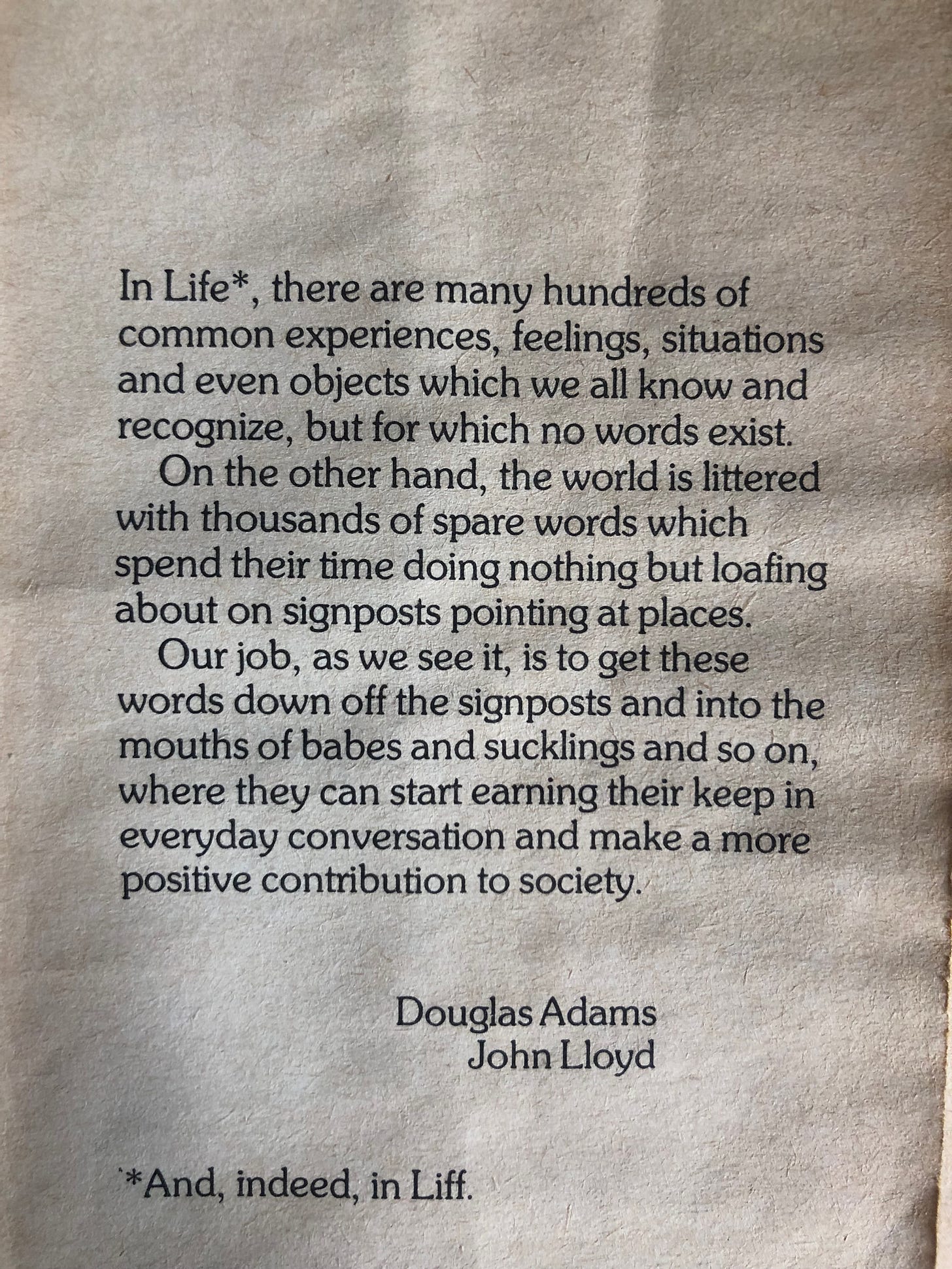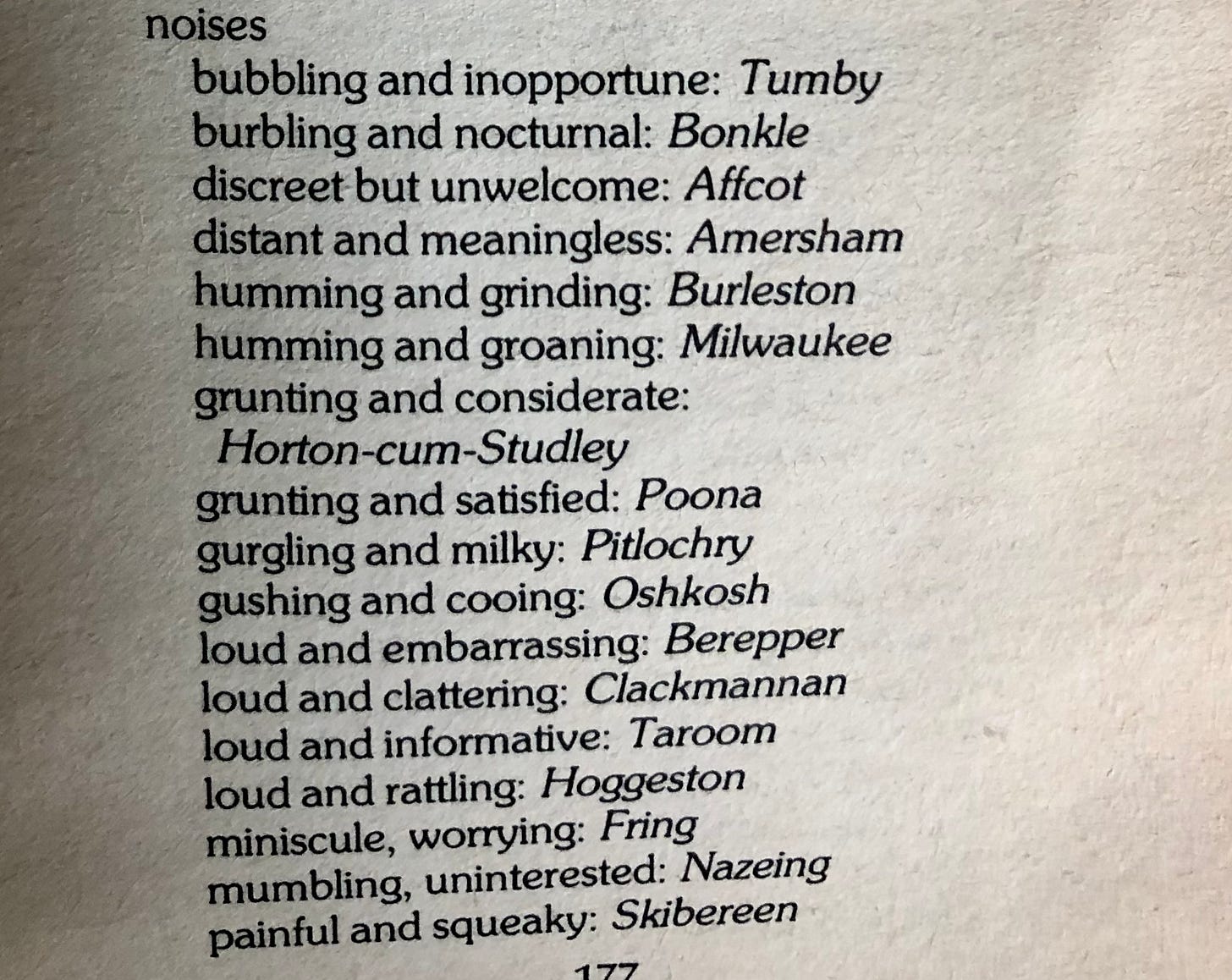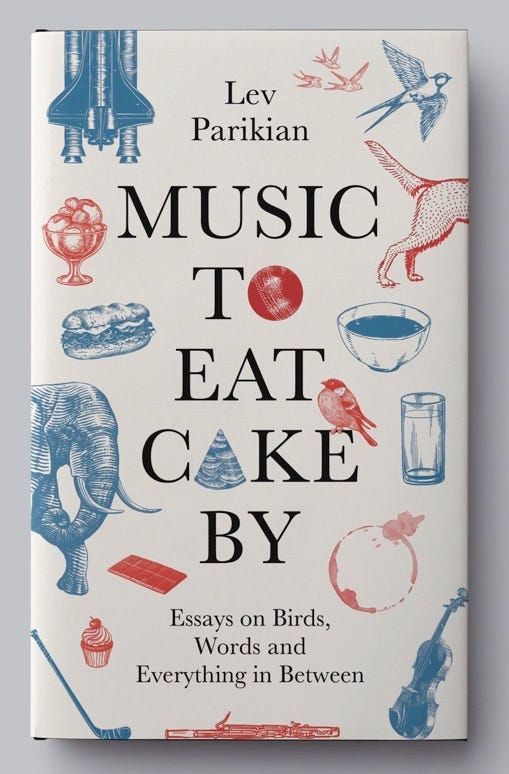Thing 1 – Indexes
Most readers take indexes for granted, but they’re like wicket-keepers, referees and pears: often you only really notice them when you get a bad one. Everything has its day, and yesterday indexes had theirs.
Regardless of the functional merits of an index, something that gives me delight is when a writer gets together with an indexer to concoct a properly funny index. These come in the same category, I’ve realised, as the end credits to the Naked Gun films. No gag opportunity unexploited, and a nice little Easter egg for people who have the patience and/or curiosity to seek them out.
Top of the comedy index pile, for me, is the one in The Meaning of Liff, Douglas Adams’ and John Lloyd’s indispensable little black book, the concept of which was best explained in its introduction.
The joy of the book – sample entries include
Ockle (n.): an electrical switch which appears to be off in both positions
and
Nubbock (n.): the kind of person who has to leave before a party can relax and enjoy itself
– is only enhanced by the index.
“Legs, things not underneath.” Marvellous.
Another fine index appears in the superb book Their Brilliant Careers by Ryan O’Neill. A masterpiece of invention throughout , Their Brilliant Careers is a remarkably clever and well executed book, and the cherry on top is the delicious index, written by O’Neill’s estranged wife, Rachel Deverall. A flavour of it can be gleaned from these five randomly selected entries.
adulterer, see O’Neill, Ryan
dickhead, see O’Neill, Ryan
egomaniac, see O’Neill, Ryan
pyromaniac, see O’Neill, Ryan
wanker, see O’Neill, Ryan
It’s a marvellous book and I urge you to read it.
Inspired by the spirit of those two books, I had tremendous fun putting together the index for Music To Eat Cake By – a book, incidentally, whose sales figures are in inverse proportion to the pride I took in producing it. It consists of forty essays on subjects given to me by readers, and here are a couple of random sections of the index.
If that piques your interest, perhaps you’ll allow me to flog you a signed copy.
Or perhaps not. Oh well, worth a try.
The skill it takes to put together a good, useful index shouldn’t be underestimated. We’ve all had the frustrating experience of not being able to find the one damn thing we need to look up, whether it’s because the page reference is wrong, or because the thing you’re looking for is filed under the wrong word (or simply omitted altogether). I’m not qualified to comment on the ins and outs of the art, but Paula Clarke Bain, professional indexer and comedy fan, definitely is. She’s written a series of excellent blogs on notable comedy indexes.



It was Paula, I discover, who managed to slip this little Easter egg into the index of Jem Roberts’s fine Fry and Laurie history Soupy Twists – with, I can only assume, the same kind of quiet glee with which F & L smuggled the names past the BBC’s censors in the original series. (Not Cumberbatch – he’s real).
And finally on this subject, I’ve just invested in Index, A History of the, by Dennis Duncan (or should that be Duncan, Dennis?) When buying such a book, it’s only human to skip the actual text and go straight to the index (compiled by the same Paula Clarke Bain, as it turns out), where I quickly found myself on a
bootless errand see fool’s errand
fool’s errand see fruitless endeavour
fruitless endeavour see hopeless quest
hopeless quest see lost cause
AND SO ON.
Well played, Paula. Well played indeed.
Thing 2 – Pianos
Not only did we have National Indexing Day yesterday, but that also coincided with World Piano Boxing Day. (Incidentally, I knew there was a World Piano Day, but I didn’t know that it was always on the 88th day of the year, 88 being the number of keys on a standard grand piano. Duh.)
The global success of the piano as a musical instrument is of course based on a lie. Or at least a fudge, which you might know as Equal Temperament. I might do a Thing some time about the workings of Equal Temperament (a full explanation tends to get both maths-y and music-y, and might be a bit much for a Friday), but it is basically a way of dividing up a musical scale into equal-sized chunks – twelve of them in the case of Western music, which is the kind you’re most likely used to listening to. There are several ways you can do the whole musical tuning thing – the great advantage of Equal Temperament is that you can go to and from any key you like without any of them sounding out of tune (this was not always the case, because… OK look I’ll just do the whole tuning thing some other time, because really I just want to celebrate some wonderful piano playing, with gratitude to the developers of the modern piano for making it such a versatile instrument.)
First, Art Tatum. Cor.
Next, Bill Evans. Also cor, but in a different way.
Maybe you don’t like jazz. Fair enough. How about Schumann? Specifically, Josef Lhévinne playing Schumann with clarity and touch and energy and easy virtuosity.
Ravel + Argerich = yes please.
Four minutes of insight into one of the more remarkable musicians of the 20th century.
Not all piano-playing is entirely serious.
Obviously you could go on forever with this kind of thing (well, I could, anyway). This small sample reflects some – but only some – of my tastes. I hope at least one of them coincides with yours. Do feel free to share your own favourites.
Thing 3 – Pencils
As if indexes and pianos weren’t enough, yesterday was National Pencil Day. It’s been quite the week for Days.
Pencils are an integral part of any musician’s life, the routine being that you write on the music to remind you to do something (louder, softer, faster, slower, BETTER) and then ignore it in performance. And of course it must be in pencil so it can be erased at a later date if you change your mind and choose to highlight something else to ignore.
So it’s natural that some musicians become... how shall we say this?... slightly pickier about the quality and grade of their pencil than might seem necessary at first glance to the disinterested outsider.
Obsessed. We get obsessed.
And the type of pencil matters.
Blackwings have become fashionable in recent years. They are an excellent brand of pencil with an equally excellent marketing department.
Despite the strong allure of the Blackwing, I like a Faber-Castell. Here’s how they’re made (pencil fetishists might need a little lie-down after watching this, especially when they see the drying room).
Thing 4 – Capercaillie
I have spent nearly 58 years on this planet, and only last week did I discover that Tampere public library was designed to resemble, when viewed from above, a capercaillie (hence its alternative name, ‘metso’, which is the Finnish word for that fine and extraordinary bird).
To be fair, it was only built in 1983, but still. That’s forty wasted years. Makes you think.
Capercaillies are truly remarkable birds. Turkey-sized, pugnacious and really quite strong, they are – when the mood is on them, by which I mean… well, you can guess what I mean – utterly fearless. Here’s one attacking a Finnish guy on a Honda.
Capercaillies are noted for their leks – gatherings of displaying males trying to outdo each other in catching the eye of determinedly unimpressed females and convincing them of their credentials vis a vis the general upkeep of the capercaillie gene pool.
This is, it’s fair to say, quite the sight. When you throw in their sounds it amounts to one of the more remarkable spectacles in the avian kingdom.
The sounds first. Grasping for a way to describe it, I usually go for this: the capercaillie sounds as if it’s rolling a ball bearing down a plughole while taking breaks to sand a grasshopper and hit some water with a tennis racket.
Inadequate, I know, but at least you now have a truly bizarre image in your head that no amount of scrubbing will expunge.
Capercaillies are also in a select group of animals (among them whales, elephants, giraffes, alligators and peacocks) capable of producing infrasound. Our hearing bottoms out, on average, at about 20 Hz, and this is just about the level of the sounds produced by capercaillies in their 'flutter jump' display. It is, as with so many aspects of animal behaviour, not known what purpose these sounds serve.
They’ve recently featured in this truly remarkable sequence from the new BBC series Wild Isles. Attenborough’s got form with capercaillies.
While the capercaillie population is not under threat globally, in Britain they’re sadly now restricted to just a few hundred individuals. The usual culprits are to blame. Us, basically.
Sigh.
Thing 5 – Grandstand
Sometimes something comes along that is so exuberant, so filled with unrestrained joy, that you just can’t help smiling. Saffron Rose (@saffronroseacts on Twitter) doing her Grandstand dance is just such a thing

Thing 6 – true size
You’ve probably seen this already – it’s been around a while – but it’s fun and interesting and you can pass a happy few minutes playing around with it, so here it is again. The true size of countries.














Six Lovely Things, thank you!
Can I add the equally lovely Alfred Brendel playing a Schubert Impromptu:
https://m.youtube.com/watch?v=2lMUCMY8Pjc
Thanks Lev. I had to stand up and rub my thighs after that pencil video. The factory must smell amazing.